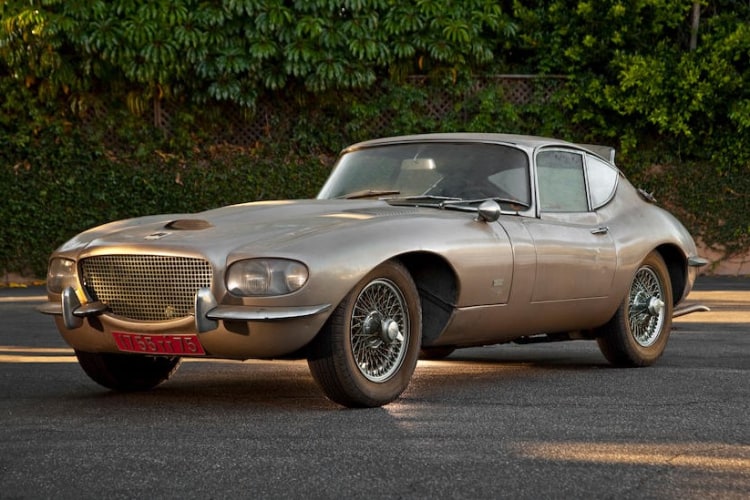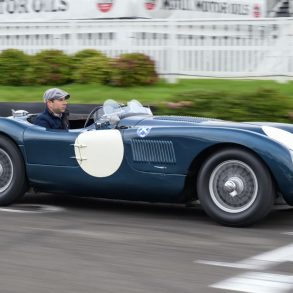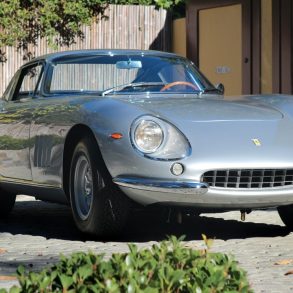It’s not easy in the case of a Jaguar E-Type coupe, even if you are as brilliant as Raymond Loewy.
As we mark the 60th Anniversary of Jaguar’s seminal E-Type, it’s interesting to recall the story of one particular 1966 4.2-liter E-Type coupe, one of two Jaguars restyled and customized by world-renowned industrial and automotive designer Raymond Loewy (the E-Type is the only one remaining; the other was created from a 1955 XK140, which was demolished in a fire in 1957).
Pichon-Parat of Sens, France, accomplished the substantial coachwork redesign on Raymond Loewy’s E-Type Jaguar. The car was owned and driven by Loewy while he lived in France and Monaco.

Loewy’s accomplishments are many and varied; His industrial and graphic design portfolio includes the uniquely tapered Coke bottle, and among his well-known current and past logo designs are those of British Petroleum (BP), the Shell Oil Company, and the United States Postal Service.
He designed everything from office equipment to locomotives and the exterior colors and graphics on Air Force One, the President of the United States’ official aircraft.
His best-known automotive design work was for Studebaker, including his assembly and spearheading of the team that designed the Studebaker Avanti of the early 1960s.

The E-Type that Loewy purchased and chose to redesign is a “second generation” 1966 Series I coupe with the 4.2-liter engine and 4-speed manual transmission.
The production E-Type was styled by Jaguar owner and patron Sir William Lyons and aerodynamicist/designer Malcolm Sayer (although Sayer always insisted his cars were designed by the wind, not really by his hand or idea).
Of course, the car has long been considered a design icon, with examples on display in countless museums and collections worldwide; many consider it to be among the most beautiful sports car designs ever; reputedly including a gent named Enzo Ferrari, who is quoted as saying such.

Loewy’s E-Type was left mechanically stock; in the process, the car was shortened fore (25 cm) and aft (12 cm) in terms of overall length, and a new nose encompassed a dual headlight treatment; the quad lights were mounted behind clear plastic covers.
Successful or otherwise you must admire him for having the guts and gumption to attempt to improve upon the timeless E-Type’s sinuous, feline shape and detailing.
This Jaguar embodies many interesting details, and Loewy’s concept certainly changes the looks of the car, even though you’d never mistake it for something other than an E-Type.

Did he improve it or not? It’s a matter of personal taste; we suspect most would say not. His redesign and the look are very mid-60s.
Raymond Loewy’s E-Type Jaguar saw the original radiator opening dispensed in favor of a large ovoid-shaped metal grille, which likely improved the E-Type’s marginal cooling capacity.
The factory taillights were replaced with Chevrolet Corvair units frenched into the quarter panels, and the dual exhaust pipes that normally exit just below the rear license plate splay outward exiting the tail of the car at approximately 45 degrees angles.
A unique Perspex “spoiler” was mounted at the trailing edge of the roof.

Loewy placed a large, red foglight in the aft cabin aimed out the rear window; rear-facing single brighter-than-a-taillight foglights are common in Europe.
The interior remains otherwise stock, save the mounting of a large, chrome flashlight on the center front console.

When offered at auction sale in 2010, the car was original, somewhat patinated, yet in far better nick than the average barnfind, and exactly as designed by Loewy and constructed by Pichon-Parat.
I drove it briefly, and it felt in generally solid mechanical condition, although it needed servicing and brake system refurbishment.
The car was consigned for auction sale by the family of the third owner, the late architect and automotive designer James Murray Hunt, who studied under Loewy early in his career.

At some point, Loewy sold the car to another individual in France, who owned it for some time, before advertising it in The New York Times (or The Wall Street Journal).
Hunt spotted the advertisement in 1970, purchased the car sight unseen, and imported it to San Diego, California, where he owned it for the rest of his life. It spent 40 years hidden away in Hunt’s garage and was considered lost by much of the motoring and automotive design communities.

The custom one-off, designed by Raymond Loewy, was offered publicly for sale for the first time since 1970, at a Bonhams auction in mid-2011. It sold for $128,000 including buyer’s premiums and commissions.
I’ve learned that the anonymous new owner did not enjoy the car’s patina and originality and has since given it new paint and a full cosmetic restoration, making me think that Loewy would either be proud or disappointed that the original handiwork has been freshened up.
Photos of Raymond Loewy’s E-Type Jaguar Courtesy of Bonhams











Loewy did not succeed by any measure.
I agree.
Story goes that Loewy left most of the design done in his studio up to the talents of those who worked there……since most of the other stuff the studio turned out was pretty good….most of those who did the good looking stuff must have been on vacation when he did this abomination as his personal car….it is beyond disgusting looking.
That’s putting it mildly.
Raymond Loewy’s E-Type coupe is even uglier than a 2 + 2 E-Type coupe. It looks like the work of an amateur backyard customizer rather than the work of a well-known automotive designer..
When I bought my 61 E-Type roadster at the age of 21 some Jaguar guy told me, that the ugly 2+2 is the top choice for an E-Type connaisseur. Now 40 years later I would like to grab me a Series 1 2+2 in some color like golden Champaign and inside red or bisquit more than any othe car in the world…
your words to describe his ugly F…-up are choosen nicely balanced
he certainly suceeded in turning beauty in to beast.
John Becker
agreed. the destruction of a masterpiece!
Couldn’t have said it better!
Agreed.
Horrible!
He’s turned it into a Vauxhall Victor at the front!
Perhaps many comments are a bit overbearing. They are looking at it through the lense of hindsight, and viewing it from the perspective of the butchery of an icon. Yes, he did custom this classic. If someone did that to an E-type today, they should have their head examined.
But that’s in hindsight. At the time this customization was done, the car wasn’t a vintage classic, just a first rate sports car. He customized it to taste, and while certainly not better than the original design, many would say it isn’t unattractive. The finished product looks a little Italian to me. Very ’60’s GT roadracer . And it is certainly a rarity. It had a quality of it’s own, and can be respected for that.
keep in mind that some of loewy’s ‘best ever’ designs were made by virgil exner.
It’s horrible, the sleek lines destroyed, Frankenstein monster comes to mind
I saw this Jaguar at the Rodeo Drive Concours in June 2012. It was interesting to compare to an original E-Type.
It’s a “variant” designed and driven by it’s remarkable owner. The patina of use should have been preserved and enjoyed. Back in the day I enjoyed driving these cars as they were meant to be driven, on the roads they were made to drive, for the fun of it, with respect but without fear of their investment value. To see them turned into shiny eye candy by collectors who priortize how they look from the outside over how they feel blasting down a small twisty road, at night in the fog… well, your loss I guess Mr or Ms rich person.
The Loewy E-Type seems to have similarities, front, rear and side, to the Lancia Fulvia Sport Zagato 1.3 of 1967. I’m not sure which came first, or who influenced whom, as the production date of the Jag and the limited production of the Lancia are very close together, and no specifics of design and modification dates of the Jag have been mentioned in auction descriptions or magazine articles.
PS. I love the look from the rear, the front not so much but the chronic cooling problems of all driven-hard big Jag sixes was probably worth the sacrifice.
Good grief that is horrible….
Sorry but I don’t see any improvement. I like the original design.
For my money he should have left well alone but it was his money and as they say, you pays your money and takes your choice.
I think he ruined the looks of it.
Totally ugly…..then and now !
Raymond Lowey also had a hand in redisigning the Pennsylvania Railroad’s famous GG1 Locomotive. The initial exterior design of the GG1 was rather unappealing and somewhat boxy with riveting used for the sheet metal car body. Wanting the locomotive to have a classier and more streamlined look the Pennsylvania hired renowned industrial designer Raymond Loewy to improve her looks (Loewy was also hired by the PRR for several projects, including fashioning the railroad’s famous Broadway Limited). While his touches were subtle they were perfect. Loewy suggested the car body be welded rather then riveted giving the locomotive a more streamlined look (he also softened the edges and curves a bit).
Loewy also gave the GG1 the famous “cat whiskers” pinstriping livery, which would go on to be used as the Pennsy’s standard paint scheme. There’s a great print called Lowey’s Legend of the famous #4935 at speed.
Very interesting read, thx Matt! Keep up the great work, best regards from Canada, gary c Shapiro, Toronto
What a hack! Despite his ‘rep’, if this doesn’t show what was under his skirt, then you’re as creatively blind as he
obviously was! He should have stopped at the Coke bottle…..but no…..he wanted to create this horror of horrors!
Lowey was blinded by his enchantment with his lack of true talent as exhibited here…regardless of period.
This guy should have been banned from owning a pencil.
I love most of what Loewy did during his lifetime but this is a fail of epic proportions. My eyes are burning just looking at it.
Sorry, Mr Lowery, I’m with the rest of the world. For a man that designed the Studebaker Avanti, one of the most beautiful cars ever built I don’t know what happened with this XKE.
Sorry, do you need to get your eyes checked? I wouldnt put that, or this EType, in the top 1000.
Appalling design.
I’m glad Loewy never got ahold of my 1966 black/black 4.2 FHC that I ordered and took delivery in March 1966. He should have talked to Enzo first before starting this madness.
Why would anyone destroy the perfect aesthetics of an XKE coupe. Someone would have to pay me to buy that monstrosity.
Can you imagine what Enzo Ferrari would say about the MESS that Loewy made out of a beautiful car.
I love the original Sayer/Lyons design but wouldn’t mind to have this E-type with Loewy touch in my garage! 😊
Bernard Marreyt
Perhaps if he’d called in Bob Bourke…..
They say that “beauty is in the eye of the beholder” well, in the eye of this beholder Loewy did not enhance the beauty of the original.
Too bad nobody had the nerve to tell the Maestro he produced an ugly baby.
That car is an abomination.
Looks bloody ugly
The head on pict.imakes it look unique…not bad looking…the rest are not real pretty…..Sorry
Well, he ruined it.
I see that he also redesigned the wheel openings too, a feature of the Avanti. I think Loewys talent was recognizing other designers talents. Like Bob Bourke who designed the 53 Studebaker “lowboy”. If Mr. Loewy did this himself then he messed up a good thing, if one of his minions penned it he should have sent him back to the drawing board.
Don’t mess with success. One might remember the most successful outside coachwork design on a British car was Giugiaro’s original Lotus Esprit. Not a job done by an ‘industrial designer’ such as Loewy. Loewy get good marks for his work for Studebaker, but I’m glad he never did work for Jaguar.
Truly, I’m not surprised by all these negative comments !
Just common sense… and taste.
An Avanti, an E-Type and an AMC Pacer roll into a bar. The Avanti turns to the E-Type and says…
The asymmetrical wheel arches remind me of the Avanti. Other than that, the car is an embarrasment.
I saw this Jaguar at a body shop in Glendale CA a few years ago, then driving in Burbank. I think we should allow Mr. Loewy to have altered this E-Type to his own taste, just the same as we allow customizers to to “improve” their vehicles.
Agree with most comments, not a good thing to see. Lowery did some very nice work, but this Jaguar butchery was not one.
The piece of crap I have seen.